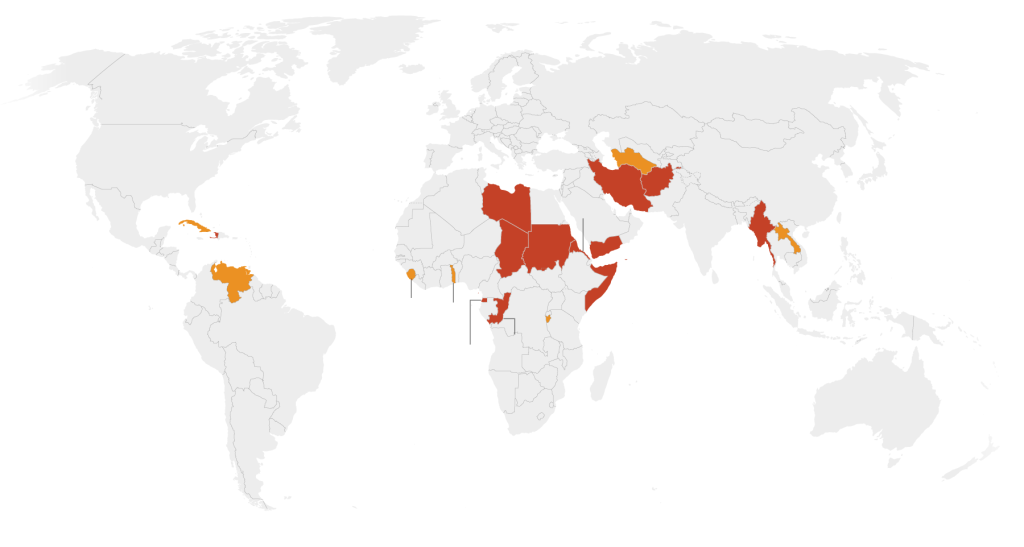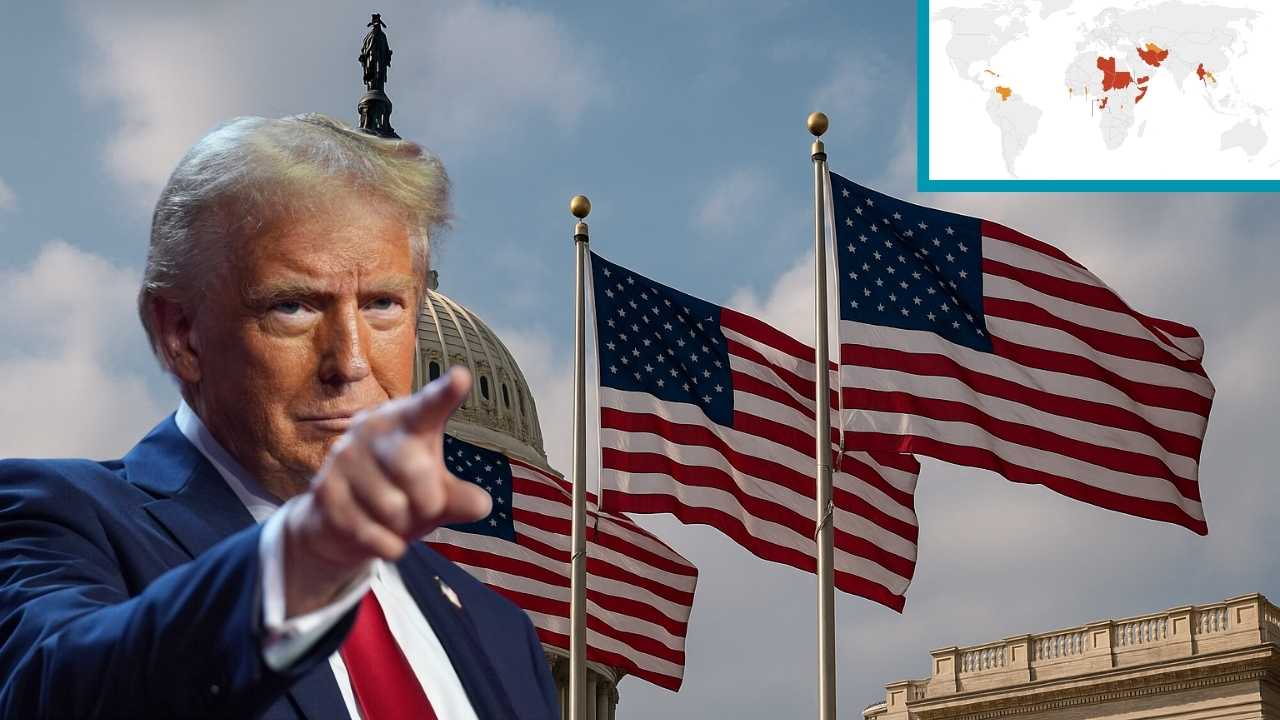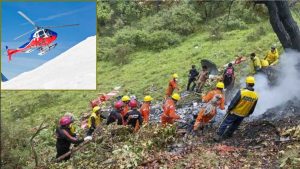In a sweeping move aimed at reasserting national security priorities, President Donald Trump has issued a renewed US Travel Ban that is already being described as one of the most consequential immigration policies in modern US history. Officially taking effect on June 9, 2025, at 12:01 AM EDT, Trump’s Travel Ban targets 12 countries with full bans and seven with partial restrictions—impacting travel, immigration, and employment on a large scale.
The list of 12 countries under a full travel ban includes —Afghanistan, Myanmar, Chad, Congo (Brazzaville), Equatorial Guinea, Eritrea, Haiti, Iran, Libya, Somalia, Sudan, and Yemen. The other seven countries facing partial restrictions, include Burundi, Cuba, Laos, Sierra Leone, Togo, Turkmenistan, and Venezuela.
The policy, introduced under the shadow of a recent violent attack in Boulder, Colorado by an Egyptian national on Jewish community (ironically, Egypt is not among the banned nations), cites threats to national security, high visa overstay rates, and poor cooperation with US immigration authorities as major drivers for inclusion on the list.
What Happens to Visas Granted Before 9 June 2025?
A significant question on many minds is: what’s the fate of existing visas issued before the US Travel Ban takes effect? Fortunately, the proclamation offers some clarity.
According to the document signed by President Trump, the travel ban will not revoke visas that were issued before June 9, 2025. In explicit terms, the order states that no immigrant or non-immigrant visa granted before the effective date will be invalidated as a result of this policy. This ensures that individuals who are currently in possession of a valid visa can continue with their travel plans, provided that they arrive in the United States before the ban takes effect.
However, this protection only applies under certain conditions. The travel ban primarily targets foreign nationals who are outside the United States as of June 9 and do not possess a valid visa on that date. Those individuals will be barred from entering the country under the new rules. This means that if someone applies for a US visa after June 9 and hails from one of the listed countries, they are likely to face outright rejection unless they fall under a limited category of exceptions.
Singapore: The World’s Most Powerful Passport
Who Is Exempt from the US Travel Ban?
There are specific categories of people who are exempt from the ban, even if they belong to one of the 19 affected countries:
- Lawful permanent residents (green card holders)
- Dual nationals, if they travel using a passport from a non-banned country
- Diplomats holding valid non-immigrant visas
- Athletes and immediate relatives traveling for events like the Olympics or World Cup
- Immediate family members holding immigrant visas
- Children being adopted
- Afghan Special Immigrant Visa holders
- US government employees on Special Immigrant Visas
- Persecuted religious or ethnic minorities from Iran
Implications for Future Travelers after Trump’s Travel Ban
Anyone applying for a visa from the banned countries after June 9 will be subject to the new rules. Barring a few exceptions, most visa categories—tourist, student, business, and even work-related visas—will either be denied outright or face significant limitations.
This policy is expected to have a major impact on international students, tech professionals, family-based immigrants, and refugees.
Safe and Cool Summer Destinations Away from Conflict Zones
Reason of Trump’s Travel Ban on These Countries?
The reasoning behind Trump’s Travel Ban is multifaceted and varies by country. The official proclamation broadly cites national security, public safety, and immigration enforcement failures as justifications. But a closer look reveals three major grounds for inclusion:

1. Security Concerns
Countries like Afghanistan, Iran, Libya, Somalia, and Yemen are cited for lacking a reliable central authority capable of issuing verifiable civil documents such as passports. These nations are also flagged for having little or no control over large swaths of their territory, making it difficult for US authorities to effectively vet travelers.
Afghanistan
Afghanistan is governed by the Taliban—classified as a Specially Designated Global Terrorist group (SDGT).
Despite past US support for Afghan allies, high visa overstay rates persist:
- 9.7% overstay rate for B1/B2 visas
- 29.3% overstay rate for student/exchange visas
Iran
Iran, long accused of being a state sponsor of terrorism, is noted for its support to proxy groups such as Hezbollah and Hamas. Trump’s proclamation calls out Iran’s role in regional instability, highlighting the country’s stalled nuclear negotiations. Iran also refuses to accept deported nationals and does not share criminal data with US agencies.
Libya
Described as a hub of historical terrorist presence, Libya lacks any reliable vetting infrastructure. There are concerns about violent extremists using Libyan travel documents to enter the US.
Yemen
Yemen is still embroiled in civil war, with parts of the country under the control of the Houthis, a group that the US has actively engaged in military operations against. Trump’s proclamation states that Yemen’s government has lost effective control of the country, making background checks nearly impossible.
Somalia
Somalia is described as a “terrorist safe haven,” with its central government struggling to maintain law and order, one of the weakest governments in the world. It is accused of:
- Lacking control over national territory
- Failing to cooperate on deportations
- Being unable to vet outbound travelers effectively
Exciting Family Adventures Await at Heritage Resorts in Mauritius!
2. High Visa Overstay Rates
Several nations, including Chad, Equatorial Guinea, Haiti, and Congo-Brazzaville, were flagged for unacceptably high visa overstay rates. These overstay statistics pertain to both business/tourist (B1/B2) visas and student/exchange visas (F1, J1, etc.). Myanmar, Eritrea, and Sudan are also accused for high overstay rates along with some other allegations.
Chad
Chad faces one of the highest overstay rates:
- 49.54% for tourist visas
- 55.64% for student visas
The Trump administration also cites “blatant disregard for US immigration laws.”
Haiti
The US highlights the surge of illegal Haitian immigration under the Biden administration. Lack of effective law enforcement and gang violence in Haiti are also cited. Key data points include:
- Tourist overstay: 31.38%
- Student visa overstay: 25.05%
Equatorial Guinea
Equatorial Guinea reported one of the highest student visa overstay rates at 70.18%. Aslo, its government is also cited for poor civil document management.
- 21.98% for tourist visas overstay
- 70.18% for student visas overstay
Congo (Brazzaville)
Although smaller in numbers, Congo is flagged for:
- 29.63% overstay for tourists
- 35.14% overstay for students
3. Lack of Cooperation in Deportation and Criminal Record Sharing
Countries like Eritrea, Sudan, and Myanmar have also been cited for failing to cooperate with the United States in accepting deported nationals or sharing criminal record information. In Eritrea’s case, the US alleges that the country is both incompetent in issuing trustworthy travel documents and unwilling to provide vital records about its citizens.
Myanmar (Burma)
Myanmar is accused of refusing to accept deported nationals. Also, the overstay rates are high;27% for tourists, 42% for students.
Eritrea
This country is accused of failing to issue secure travel documents, not providing criminal records. Also they refuse to accept deportees.
Overstay rates are also high:
- 20%+ for tourists
- 55%+ for students
Sudan
Sudan is flagged for document fraud, Poor passport vetting infrastructure.
Overstay rates:
- 26.3% for business travelers
- 28.4% for students
Countries Under Partial Ban
The seven countries under partial restrictions include Burundi, Cuba, Laos, Sierra Leone, Togo, Turkmenistan, and Venezuela. While they are not completely barred, they face limitations on specific visa categories, often related to green card sponsorships or reduced visa durations.
In the case of Venezuela, the US accuses its government of lacking a “competent or cooperative” central authority for issuing travel documents and refusing to repatriate its citizens. Cuba, still listed as a state sponsor of terrorism since 2021, faces similar restrictions along with allegations of visa overstays and deportation non-compliance.
European Travel Costs Hikes: Schengen Visa Fees Increased by 12%
Broader Impact of Trump’s Travel Ban
The travel ban has stirred anxiety across sectors such as tech, healthcare, and education, all of which greatly rely on foreign-born professionals. For countries under full bans, employers will be unable to hire workers or sponsor green cards. Even for the partially banned countries, work visa durations will be limited and green card access will be blocked.
STEM talent, medical professionals, and academic institutions are expected to be hit the hardest. The education and healthcare industries alone employ nearly 5.5 million foreign-born workers, a significant portion of whom hail from countries affected by this policy.
While individuals with existing visas are temporarily safeguarded, the future of immigration from these 19 countries remains uncertain under the new administration. As legal challenges and humanitarian concerns emerge, this policy is expected to stay at the center of political and public debate in the coming months.
Sources: BBC News, Economic Times, The Guardian, Mint






![Top Travel News of July 2024 [First Fortnight ] 8 Read more about the article Top Travel News of July 2024 [First Fortnight ]](https://travelentice.com/wp-content/uploads/2024/07/Top-travel-news-July-2024-300x169.jpg)
